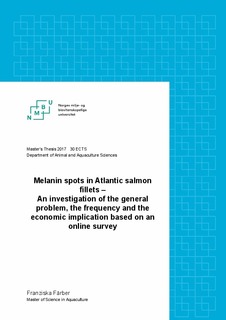| dc.contributor.advisor | Mørkøre, Turid | |
| dc.contributor.advisor | Hörstgen-Schwark, Gabriele | |
| dc.contributor.advisor | Rørvik, Kjell-Arne | |
| dc.contributor.author | Färber, Franziska | |
| dc.date.accessioned | 2017-08-16T10:33:17Z | |
| dc.date.available | 2017-08-16T10:33:17Z | |
| dc.date.issued | 2017 | |
| dc.identifier.uri | http://hdl.handle.net/11250/2450885 | |
| dc.description.abstract | The appearance of a product is an important quality feature that influences the purchasing decision of consumers. In this respect, dark stained melanin spots in Atlantic salmon fillets have become a major issue in recent years.
The main objective of the thesis was to investigate how the salmon processing industry is rating the problem with fillet melanin spots, and economic implications. The study was based on an online survey that was distributed to the processing industry in Norway, Germany and Poland during October and November 2016. Additionally, a case study was conducted to exemplify utilisation of the survey results. The results of the survey showed that melanin spots together with pale fillet colour are the biggest problems, and that melanin spots appear more frequently compared to other quality issues. On average melanin spots appear in 16.4% of the salmon fillets according to the processing industry, who believe that vaccine and stress are the major causes to the problem. For weak greyish spots and distinct melanin spots up to 3cm the general procedure was to remove only the pigmented tissue (9% average price loss, PL). Fillets with larger distinct spots (3-6cm) were generally downgraded (PL for downgrading 26%) whereas fillets with large pigmented areas (>6cm) were generally removed from the food chain (PL 67% on average, modal value 100%). Smaller spots were appearing most frequently; i.e. the bigger the size of the melanin spots, the less frequent occurrence. In the case study (salmon fed two different feeds), results for the economic loss (EL) due to melanin spots were used (weak, small melanin spots 8% EL, distinct spots less than 3cm 15% EL, spots 3-6cm 24%, pigment area >6cm 44% EL). It is concluded that melanin spots cause severe economic losses for the salmon processing industry, in particular spots larger than 3cm. Furthermore, it is concluded that the results from the survey can be used to calculate economic implications of melanin spots and economic benefits of reducing the occurrence and severity of melanin spots in salmon fillets. | nb_NO |
| dc.language.iso | eng | nb_NO |
| dc.publisher | Norwegian University of Life Sciences, Ås | nb_NO |
| dc.rights | Attribution-NonCommercial-NoDerivatives 4.0 Internasjonal | * |
| dc.rights.uri | http://creativecommons.org/licenses/by-nc-nd/4.0/deed.no | * |
| dc.subject | Melanin | nb_NO |
| dc.subject | Atlantic salmon | nb_NO |
| dc.subject | Aquaculture | nb_NO |
| dc.subject | Salmon fillets | nb_NO |
| dc.subject | Quality issues | nb_NO |
| dc.title | Melanin spots in Atlantic salmon fillets : an investigation of the general problem, the frequency and the economic implication based on an online survey | nb_NO |
| dc.type | Master thesis | nb_NO |
| dc.subject.nsi | VDP::Agriculture and fishery disciplines: 900 | nb_NO |
| dc.source.pagenumber | 84 | nb_NO |
| dc.description.localcode | M-AA | nb_NO |

